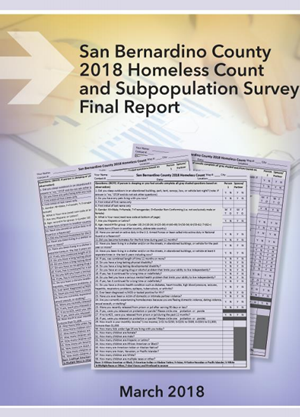San Bernardino, Ca – The Interagency Council on Homelessness released the 2018 Point-in-Time Count (PITC) for the County of San Bernardino.
The recent PITC affirmed that countywide efforts to reduce the chronically homeless population have been successful with an 18 percent reduction in 2018. However, Southern California’s affordable housing crisis is negatively impacting an emerging population of homeless adults, particularly seniors
on a fixed income.
[ecko_button color=”green” size=”large” url=”http://wp.sbcounty.gov/dbh/sbchp/wp-content/uploads/sites/2/2018/04/SBC-2018-Homeless-Count-Final-Report.pdf”]Download The Report[/ecko_button]

Ending homelessness in San Bernardino County is a priority for the Board of Supervisors who created the San Bernardino County Homeless Partnership in 2007. This past year, more than 140 chronically homeless people with mental health issues have been housed. In July 2015, the board held a special session on efforts to reduce the homeless veteran population. In August 2016, the board once again held a special session resolving to reduce the population of chronically homeless in the county. As of March 2018, through the board’s initiative on homeless veterans, 1,128 veterans and families were successfully housed in our County.
“Combating the growing number of homeless people in the City of San Bernardino, County and State is a critical issue that requires real action at every level of government,” said San Bernardino Mayor Carey Davis. “Our city’s recent accomplishments of exiting bankruptcy, adopting a new charter and securing strong leadership has launched our recovery and renaissance as a city. Solving San Bernardino’s high rates of homelessness is critical as we move forward.”
San Bernardino’s strategy to decrease homelessness within the city is a multi-layered approach that includes one-on-one interaction and support, transitional shelters and permanent supportive housing. This year, San Bernardino adopted a Step Up model that uses the “Housing First” approach that offers permanent, affordable housing for individuals and families experiencing homelessness, and then provides the supportive services and connections to community-based supports people need to keep their housing and avoid returning to homelessness. Step Up efforts are further supported by the San Bernardino Police Department and San Bernardino’s Quality of Life team.
“The numbers of homeless unaccompanied women rose this year, but that may be in part to the additional focus on counting them accurately,” said Tom Hernandez, homeless services officer for the Community Development and Housing Agency.
“I have always appreciated those cities that have diligently worked to address their homeless population needs, and now I am encouraged to see additional cities embrace the same the role to reduce and prevent homelessness in their communities,” said San Bernardino County Supervisor Josie Gonzales, chair of the Interagency Council on Homelessness. “Ultimately, aggressively working through our mayors and council members, planning commissioners, and garnering community’s support, the solution is to create a countywide strategic plan focused on meeting our homeless population’s diverse needs.”
As Step Up works with the City’s homeless individuals to create a plan out of poverty, the City’s plan for almost 500 units of transitional and permanent housing units offer long-term solutions.
“We know that housing the homeless residents in our community will take a great deal of time and effort, but the City of San Bernardino is willing as it’s vital to our recovery and future,” said Mayor Davis. “We will have the ability to offer long-term housing solutions, however a call must be made to all cities to serve those within their city limits, which cannot include transporting them to neighboring communities. Lastly, state policies must be also reviewed as AB 109 is negatively impacting our community and homeless population.”
The 2018 report lists six recommendations to end homelessness amongst the pre-identified populations:
- Encourage each city to adopt their unsheltered homeless count numbers as baseline numbers;
- Completely align with a Housing First model and low barrier approach for chronically homeless individuals and families;
- Completely align with a rapid rehousing and low barrier approach for non-chronically homeless individuals and families;
- Align the current homeless services delivery system with a goal of ending homelessness among unaccompanied women by 2020;
- Increase the Number of Permanent Supportive Housing Units; and
- Increase Rapid Rehousing Assistance.
Every other year HUD requires the Point In Time Count to be conducted within the last 10 days of January. The Interagency Council on Homelessness (ICH) made the policy decision to do the count every year to better monitor and respond to the homeless trends. This year, the San Bernardino County Point In Time Count was held on Jan. 25, led by the County’s Homeless Partnership (SBCHP), ICH and the Institute for Urban Initiatives.
More than 500 community volunteers, community groups, faith- and community-based organizations, County departments, city representatives and staff, homeless service providers, law enforcement and elected officials assisted with the count. ICH meetings are held the 4th Wednesday of the month at 850 E. Foothill Blvd. Rialto, CA, starting at 9:00a.m.
[ecko_button color=”green” size=”large” url=”http://wp.sbcounty.gov/dbh/sbchp/wp-content/uploads/sites/2/2018/04/SBC-2018-Homeless-Count-Final-Report.pdf”]Download The Report[/ecko_button]

